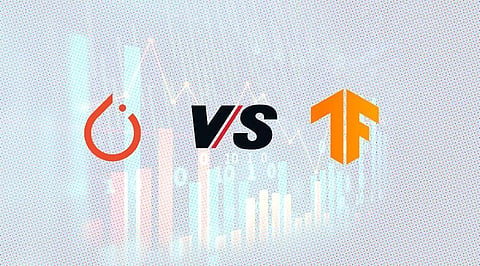

Before we explore the PyTorch vs TensorFlow differences, let's take a moment to discuss deep learning. Deep learning and machine learning are both parts of the artificial intelligence family, with deep learning being a subset of machine learning. It is on data scientists to choose the best of the two.
PyTorch is one of the most recent deep learning frameworks, built by the Facebook team and released on GitHub in 2017. More information on its development may be found in the research paper "Automatic Differentiation in PyTorch." TensorFlow is a Google-developed end-to-end open-source deep learning framework that was launched in 2015. It's well-known for its documentation and training assistance, scalable production and deployment choices, many abstraction levels, and support for various platforms including Android. If you want to be a successful data scientist or AI engineer, you must master the various deep learning frameworks that are currently available. In this article, we'll enlighten you about the best option for data scientists.
TensorFlow and PyTorch both provide valuable abstractions that make model creation easier by minimizing boilerplate code. They vary in that PyTorch takes a more "pythonic" approach and is object-oriented, whereas TensorFlow provides a wide range of possibilities.
PyTorch is used for many deep learning projects today, and its popularity among AI researchers is growing, despite being the least popular of the three main frameworks. Trends indicate that this is about to change.
PyTorch is used by researchers who want flexibility, debugging capabilities, and short training duration. It is compatible with Linux, macOS, and Windows.
TensorFlow is a favored tool among industry experts and researchers because of its well-documented framework and plenty of trained models and tutorials. TensorFlow provides improved visibility, allowing developers to troubleshoot and follow the training process more effectively. However, PyTorch only offers limited visualization.
TensorFlow also outperforms PyTorch when it comes to deploying trained models to production, owing to the TensorFlow Serving framework. Because PyTorch lacks such a framework, developers must rely on Django or Flask as a back-end server.
PyTorch achieves optimal efficiency in data parallelism by relying on Python's intrinsic capabilities for asynchronous execution. To support distributed training with TensorFlow, you must manually code and optimize every operation done on a given device. To summarise, everything from PyTorch can be replicated in TensorFlow; you simply have to work harder at it.
Because of its prominence in the research community, if you're just getting started with deep learning, you should study PyTorch first. However, if you're already familiar with machine learning and deep learning and want to secure a job in the sector as quickly as possible, start with TensorFlow.
Initially, neural networks were employed to tackle simple categorization tasks using cameras, such as handwritten digit identification and detecting a car's registration number. However, with the most recent frameworks and NVIDIA's high computational graphics processing units (GPUs), we can train neural networks on terabytes of data and tackle significantly more complicated issues. Among the major accomplishments is state-of-the-art performance on the IMAGENET dataset using convolutional neural networks developed in both TensorFlow and PyTorch. The trained model may be utilized in a variety of applications, including object identification, picture semantic segmentation, and many more.
Although a neural network's design may be implemented on any of these frameworks, the output will be different. There are several framework-dependent factors in the training process. For example, if you're using PyTorch to train a dataset, you may speed up the process by leveraging GPUs, which operate on CUDA (a C++ backend). TensorFlow can access GPUs, but it uses its inbuilt GPU acceleration, so the time it takes to train these models will always vary depending on the framework.
TensorFlow is the obvious victor when it comes to deploying trained models to production. TensorFlow serving, a framework that employs REST Client API, allows us to easily deploy models in TensorFlow.
These production deployments are now easier to manage in PyTorch than in the newest 1.0 stable version, but there is no mechanism for deploying models directly to the web. As the backend server, you must use Flask or Django. If performance is an issue, TensorFlow serving may be a better alternative.
PyTorch and TensorFlow both published new versions recently: PyTorch 1.0 (the first stable version) and TensorFlow 2.1. Both of these versions offer significant improvements and new features that make training more efficient, seamless, and powerful.
Join our WhatsApp Channel to get the latest news, exclusives and videos on WhatsApp
_____________
Disclaimer: Analytics Insight does not provide financial advice or guidance on cryptocurrencies and stocks. Also note that the cryptocurrencies mentioned/listed on the website could potentially be scams, i.e. designed to induce you to invest financial resources that may be lost forever and not be recoverable once investments are made. This article is provided for informational purposes and does not constitute investment advice. You are responsible for conducting your own research (DYOR) before making any investments. Read more about the financial risks involved here.
